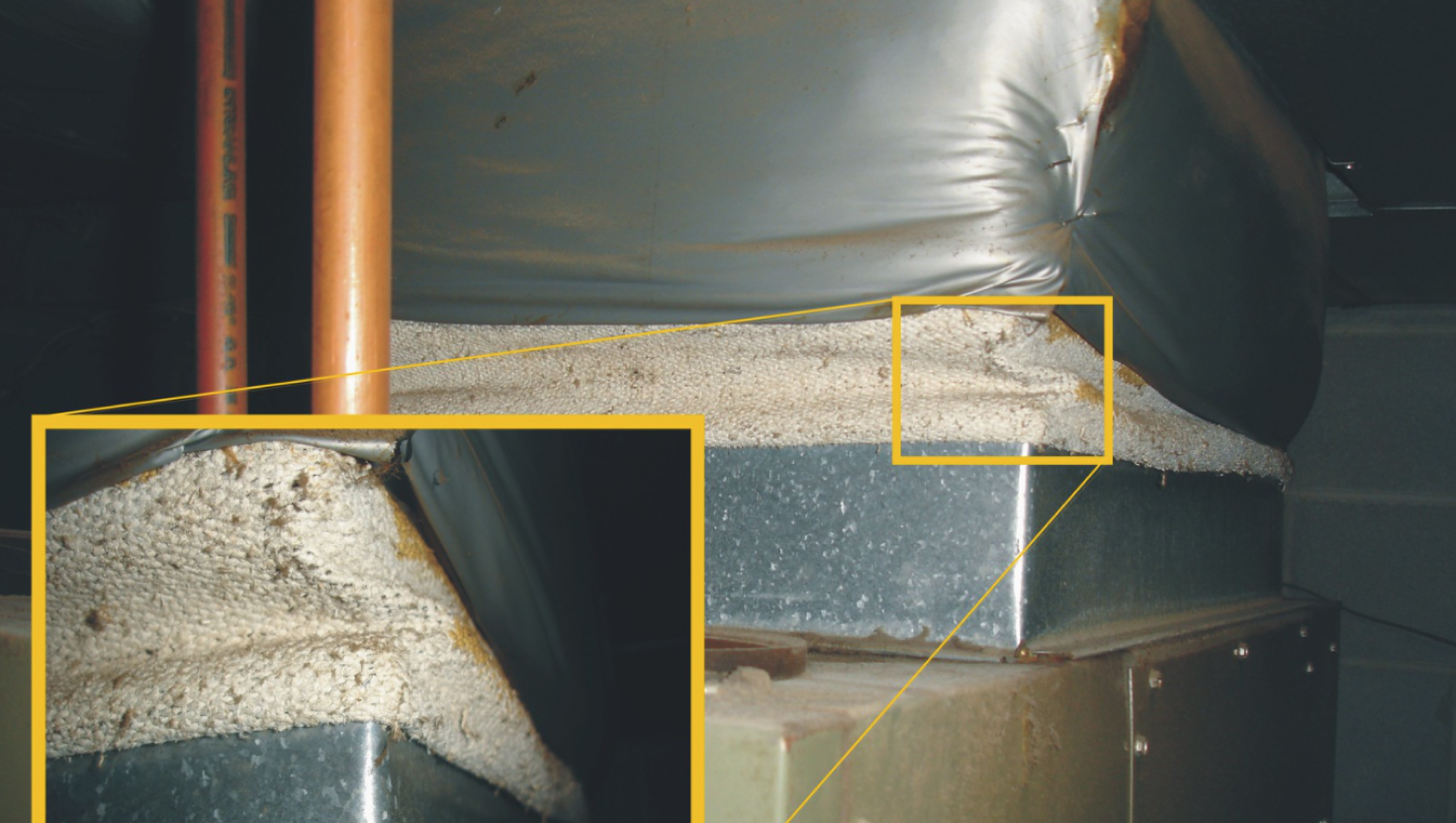Get Your Free Mesothelioma Guide

Find a Top Mesothelioma Doctor

Access Help Paying for Treatment

Asbestos tape was used to seal air ducts in heating, ventilation and air conditioning (HVAC) systems. Workers who installed and repaired asbestos ductwork connectors developed asbestos-related diseases and successfully sued manufacturers for compensation for medical costs, lost wages, pain and suffering.

Ducts that help keep the air warm or cool are usually connected to machines with flexible duct connectors made of tough fabric. For many years, materials woven from asbestos fibers were used to make these connectors.
Metal air ducts connect all the rooms in a home or building to HVAC equipment. Noise and vibrations are produced by the equipment. Without something in between, the noise and shaking could travel through the entire ventilation system.
This problem is prevented by installing a flexible duct connector between the machinery and the ductwork. This connector must be able to take in vibrations and handle hot and cold air from HVAC systems.
For several decades during the mid-20th century, companies used asbestos to make duct connectors that could handle a lot of heat. Asbestos fibers are durable and fireproof, yet flexible enough to be woven into fabric. During the 1980s, manufacturers began using other heat-resistant materials to make duct connectors. International companies may still use asbestos in duct connectors, and there are no regulations to prevent them from entering the U.S.
Unfortunately, many old buildings still contain degrading asbestos materials in HVAC systems. The tradesmen who work with these materials are at risk of developing mesothelioma or other asbestos-related diseases.
Coarse Fabric Duct Connector
Duct connectors were manufactured as simple strips of coarse fabric woven from nearly pure asbestos yarn. They were secured to metal duct joints by clips or rivets.
Tape Duct Connector
Flexible asbestos tape of varying widths was used to seal and connect ductwork.
Vinyl or Rubber-Coated Duct Connector
More sophisticated asbestos duct connectors were coated with rubber or vinyl to provide a more airtight seal.
Paper Duct Connector
Asbestos paper was used as duct wrap insulation in HVAC systems around ductwork in basements and attics of older homes and buildings. This material often contained about 15% chrysotile asbestos.
Other asbestos materials in HVAC systems included asbestos cement, millboard and insulation. Asbestos cement transite pipe was typically used as an air duct rather than a connector. Asbestos millboard was used as a heat shield on walls and ceilings around HVAC systems. Asbestos wrap insulation was used inside ducts to improve heating or cooling efficiency.
Some of these companies, including Johns Manville, became infamous for the number of asbestos products they produced. Several were forced to file for bankruptcy under the weight of asbestos lawsuits. To reorganize through bankruptcy, they were forced to create trust funds to compensate asbestos victims.
Get Your Free Mesothelioma Guide

Find a Top Mesothelioma Doctor

Access Help Paying for Treatment

Flexible duct connectors contained significant amounts of chrysotile asbestos in the 20th century. The factory workers who produced these connectors suffered the worst asbestos exposure. Construction workers who installed, repaired or removed them were also exposed.
Occupational asbestos exposure is the No. 1 cause of work-related deaths in the world. According to a 2022 report by the European Commission, over 70,000 workers died in 2019 from past exposure to asbestos.
Exposure to asbestos in ductwork is known to cause the following diseases:
With time, duct connectors can become weak and easily break apart into tiny pieces that could be breathed in. Even rubber or vinyl-coated asbestos duct connectors may degrade to the point of releasing asbestos fibers into the air.
Microscopic asbestos dust has no scent, and exposure generally does not cause symptoms to develop until decades later. Duct connectors are positioned to affect all the air in a building. Degrading asbestos duct connectors poses a serious asbestos exposure risk.
If you are diagnosed with an asbestos-related disease it is important to seek the medical advice of a specialist. Treating these diseases early improves the chances of long-term survival.
Manufacturers of asbestos products are held liable through the U.S. court system for the diseases their products cause. Decades of personal injury lawsuits and wrongful death lawsuits revealed these companies were aware of the dangers of asbestos and decided to use the material despite its known health effects. Many people who develop asbestos-related diseases after years of working with toxic duct connectors have received mesothelioma compensation options by suing manufacturers.
A mesothelioma lawyer can review your case and guide you on the types of legal claims you may qualify to file. You may be eligible to file a lawsuit and multiple claims with asbestos trust funds.

We have more than 50 years of combined experience helping mesothelioma patients.
Chat NowAbating asbestos duct connectors should only be performed by licensed asbestos abatement professionals. Do not attempt to abate this type of asbestos product yourself. Asbestos duct connector materials become brittle with age and may release significant asbestos into the air.
Hire a licensed professional to do the job to avoid unnecessary asbestos exposure among your family or coworkers.
American ductwork manufacturers phased out the use of asbestos during the 1980s. They switched to cotton canvas or fiberglass mesh to make flexible duct connectors.
Manufacturers began testing asbestos duct connectors as early as 1938. The Johns Manville Corporation wrote about their advantages in a journal. In 1951, the National Fire Protection Agency recommended asbestos for flexible duct connectors.
Recommended ReadingYour web browser is no longer supported by Microsoft. Update your browser for more security, speed and compatibility.
If you are looking for mesothelioma support, please contact our Patient Advocates at (855) 404-4592
The Mesothelioma Center at Asbestos.com has provided patients and their loved ones the most updated and reliable information on mesothelioma and asbestos exposure since 2006.
Our team of Patient Advocates includes a medical doctor, a registered nurse, health services administrators, veterans, VA-accredited Claims Agents, an oncology patient navigator and hospice care expert. Their combined expertise means we help any mesothelioma patient or loved one through every step of their cancer journey.
More than 30 contributors, including mesothelioma doctors, survivors, health care professionals and other experts, have peer-reviewed our website and written unique research-driven articles to ensure you get the highest-quality medical and health information.
My family has only the highest compliment for the assistance and support that we received from The Mesothelioma Center. This is a staff of compassionate and knowledgeable individuals who respect what your family is experiencing and who go the extra mile to make an unfortunate diagnosis less stressful. Information and assistance were provided by The Mesothelioma Center at no cost to our family.LashawnMesothelioma patient’s daughter


Whitmer, M. (2025, January 13). Asbestos and Ductworks. Asbestos.com. Retrieved April 11, 2025, from https://www.asbestos.com/products/ductwork-connectors/
Whitmer, Michelle. "Asbestos and Ductworks." Asbestos.com, 13 Jan 2025, https://www.asbestos.com/products/ductwork-connectors/.
Whitmer, Michelle. "Asbestos and Ductworks." Asbestos.com. Last modified January 13, 2025. https://www.asbestos.com/products/ductwork-connectors/.
An occupational scientist or another expert who specializes in occupational hazards reviewed the content on this page to ensure it meets current scientific standards and accuracy.
Sean Fitzgerald, PG, is a research geologist specializing in asbestos environmental studies.
Our fact-checking process begins with a thorough review of all sources to ensure they are high quality. Then we cross-check the facts with original medical or scientific reports published by those sources, or we validate the facts with reputable news organizations, medical and scientific experts and other health experts. Each page includes all sources for full transparency.
Please read our editorial guidelines to learn more about our content creation and review process.
